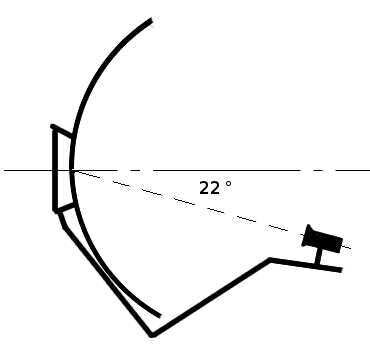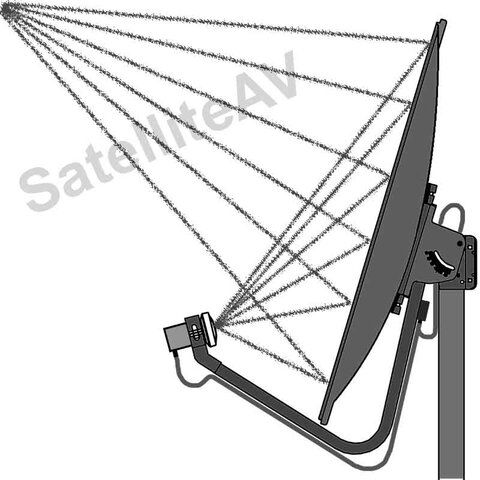Sorry I couldn't find it. Skew and aiming is easy , but , I wondered if sliding the LNB closer or farther from the dish has any effect . If so , which is more desirable , or advantageous to the signal strength ? Thanks in advance. 
LNB adjustment.
- Thread starter beer4me
- Start date
- Latest activity Latest activity:
- Replies 12
- Views 3K
You are using an out of date browser. It may not display this or other websites correctly.
You should upgrade or use an alternative browser.
You should upgrade or use an alternative browser.
- Status
- Please reply by conversation.
On some satellites or transponders you may have to move the LNBF forward or aft quite a distance to optimize, but on other satellites and transponders a 1/4" movement may result in a 10 or 20% change in Signal Quality readings.
It is quite apparent when viewing on a spectrum analyzer the effect that forward / aft LNBF placement has on optimizing the signal.
A great example of fore / aft LNBF placement into the focal sweet spot of the relector can be viewed on transponders with adjacent satellite interference. Check out satellite Galaxy 19, transponder 11842. Optimize the dish aiming using a transponder with minimal interference such as 12177. Switch over to 11842 and adjust the fore / aft placement.
It is quite apparent when viewing on a spectrum analyzer the effect that forward / aft LNBF placement has on optimizing the signal.
A great example of fore / aft LNBF placement into the focal sweet spot of the relector can be viewed on transponders with adjacent satellite interference. Check out satellite Galaxy 19, transponder 11842. Optimize the dish aiming using a transponder with minimal interference such as 12177. Switch over to 11842 and adjust the fore / aft placement.
Wow ! This is great info. Thanks guys. Continued learning keeps this hobby interesting , and , informative.
So just for curiosity sake I just went to 97w and checked those two TPs with my SAMI dish using the Openbox S9. Got 73/74% Q on 12177 and 71/72% Q on 11842? So is 11842 suppose to be harder to tune than 12177? And am I suppose to be able to get the same Q reading on both?
I don't think that's what he meant. The original question was to ask if moving the lnb toward/away from the dish had an effect on q signal level , on any given transponder. He was just giving an example to minimize adjacent signal interference.
So just for curiosity sake I just went to 97w and checked those two TPs with my SAMI dish using the Openbox S9. Got 73/74% Q on 12177 and 71/72% Q on 11842? So is 11842 suppose to be harder to tune than 12177? And am I suppose to be able to get the same Q reading on both?
A large dish on KU band will have an extremely narrow beam, so adjacent satellite interference is attenuated. I would expect similar signal qualty readings on these two transponders using an oversized reflector nullifying the adjacent satellite interference. This has little to do with placing the feedhorn in the sweet spot.
The O. P. didn't mention dish size? From what you said I was under the impression that 11842 was harder to tune and I guess I mistakenly assumed that it would be a weaker TP? I was wondering if I needed to "tweak" on mine to see if I could get them the same?
Lone Gunman,
My response was to you, as I had quoted your post. Your question was off-topic so I addressed it separately from the OPs question.
The link budget is similar between 12177 and 11842.
11842 suffers from adjacent satellite interference, so an LNBF mounted outside of the prime sweet spot will have considerable lower Signal Quality readings. In your case, the Sami dish with the narrower KU band beam pattern attenuates the adjacent satellite interference and you will observe very little reduction in adjacent satellite interference as you are not moving the scalar on your prime focus dish and the F/B ratio would affect both transponders similarly.
My response was to you, as I had quoted your post. Your question was off-topic so I addressed it separately from the OPs question.
The link budget is similar between 12177 and 11842.
11842 suffers from adjacent satellite interference, so an LNBF mounted outside of the prime sweet spot will have considerable lower Signal Quality readings. In your case, the Sami dish with the narrower KU band beam pattern attenuates the adjacent satellite interference and you will observe very little reduction in adjacent satellite interference as you are not moving the scalar on your prime focus dish and the F/B ratio would affect both transponders similarly.
Last edited:
Isn't the distance of the LNB from the dish determined by where it hits the center of the dish and the target angle (22 deg.)?

I may be off base here but if this is the optium placement, moving the lnb forward would have it aimed too low on the dish. I would think that would lower the signal Q.
How important is it to maintain the proper target angle and hitting the dish at its center?

I may be off base here but if this is the optium placement, moving the lnb forward would have it aimed too low on the dish. I would think that would lower the signal Q.
How important is it to maintain the proper target angle and hitting the dish at its center?
Last edited:
- Status
- Please reply by conversation.
Similar threads
- Replies
- 14
- Views
- 689
- Replies
- 3
- Views
- 459
- Replies
- 1
- Views
- 382
- Replies
- 2
- Views
- 434


